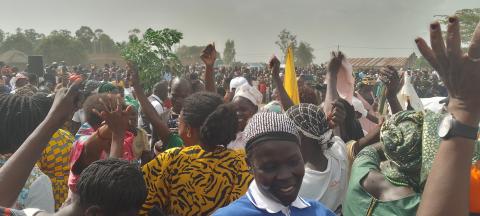GEOGRAPHY

GEOGRAPHICAL INFORMATION
Maracha District was created in FY 2009/10 and started effective operations on 1st Jul, FY 2010/11. Maracha District is found in the North Western region lying between Arua and Koboko Districts. Its District headquarters and Commercial Town is in Maracha Town Council, 24 miles north of Arua Town along the main road to South Sudan. Maracha District is bordered by Koboko District in the North, Yumbe District in the North East, Democratic Republic of Congo in the West and by Arua District in the South and South East. Maracha comprises two counties namely Maracha County and Maracha East County, 14 rural sub counties and 5 town councils, 91 parishes and 691 villages.
DEMOGRAPHIC
The 2024National Population and Housing census revealed that Maracha had a total population of 234,712, of which 109,515 were males (46.7%) and 125,197 were females (53.3%). There were 46,476households in Maracha district with an average household size of 4.9. The population by selected age groups is as follows: children (0-7) 118,827; adults (18 years and above)115,885; youth (15-24 years) 48,283; (18-30 years)= 50,706; working age (14-64 years) 130,352; older persons(60 years and above)14,908.
More details can be found in the Statistics Hub.
ADMINISTRATIVE STRUCTURE
Maracha district has two constituencies namely: Maracha East County and Maracha County. The district traditionally had 7 sub counties, one town council 42 parishes / wards and 411 villages / zones. Maracha East constituency had 4 sub counties, 1 town councils, 27 parishes / wards and 267 villages / zones. Whereas Maracha constituency had 3 sub counties, 16 parishes / wards and 149 villages / zones.
NATURAL ENDOWMENTS
The district total area is 440.4km2. The 13 shows the land areas of various sub counties in Maracha district. Maracha East constituency has a total area of 242.8 km2 and Maracha constituency 197.6km2.
Topography
The District comprises mainly of rolling plains rising from the Uganda - Congo boarder with all rivers and streams flowing eastwards towards the River Nile. The general topography of Maracha District is flat land with limited Hills and forest cover. The topography is hilly towards the North eastern part of the District in Tara and Yivu Sub Counties.
Geomorphology
The major valleys are aggraded with alluvial and swamp deposits. The aggradations are partly geomorphic, but also associated with dense growth of papyrus and other plants which block streams and cause deposition of sediments.
Soils
The soils covering most of the District are mainly ferralitic and sandy loams. These soils have fine textile with rather loose structure, which are easily eroded and leached. Most soils are acidic. Soil types in the district include:
- Yellow - red sandy, clay loams latosols varying from dark grey to dark which are slightly acidic and mainly derived from granite, gneissic and sedimentary rocks. They occur on gently undulating - hilly topography.
- Brown - yellow clay loams with lateritic horizon with a variety of dark brown to dark greyish brown, which are slightly acidic. These occur on flat ridge tops or as of undulating topography near the border with DRC.
- Light - grey- white mottled loamy soils with lateritic horizon ground, structure-less loamy sands. They are acidic - alluvial and mainly found on the lower and bottom slopes.
Wetland
Wetlands cover a small proportion of the total District area i.e. approximately 2.9% (16.6 km2) of the total land area of the District. This allows water to stay in one place long enough to maximize infiltration and thus access to water supplies for plants. There is however significant encroachments on the few available wetlands for construction, unfriendly activities of man and crop cultivation particularly rice, bananas and potatoes in the wetlands in the Urban and Rural set ups respectively. Unless the trend is reversed, the District’s wetlands are likely to be destroyed in the near future.
Climate
The District has a bi-modal rainfall pattern with light rains between April and October. The wettest months are normally August and September which receives up to 120mm/month. The average total rainfall is 1250mm. The mean monthly evaporation ranges from 130mm - 180mm. In the dry season (December -March) temperatures remain high throughout the Administrative Setup. However, this trend is now changing with rains being received in months where rains were not expected at all.
Vegetation
The predominant vegetation in Maracha District is savannah woodland with patches of planted forest cover found in all the Lower Local Governments while Natural forest cover is only concentrated in Yivu and Tara Sub Counties in the North Eastern part of the District. The bushy forests in the northern part of the District mainly comprise of natural trees with few forests comprising of planted tree species. The hills in the east have fertile soils around them that has led to people migrating to settle along the hill foots and slopes.
Water resources
Maracha District generally has a good network of surface and ground water resources. Rivers Enyau, Ayii, Enve, Yoo, Oluffe are some of the main and important rivers in the District. They all have their source from Uganda’s boarder with Democratic Republic of Congo which is a water shade and all the waters drain towards east mainly into rivers that empty into the River Nile.Good number of swamps exist in the District but are being destroyed due to their overuse and mans’ activities.
